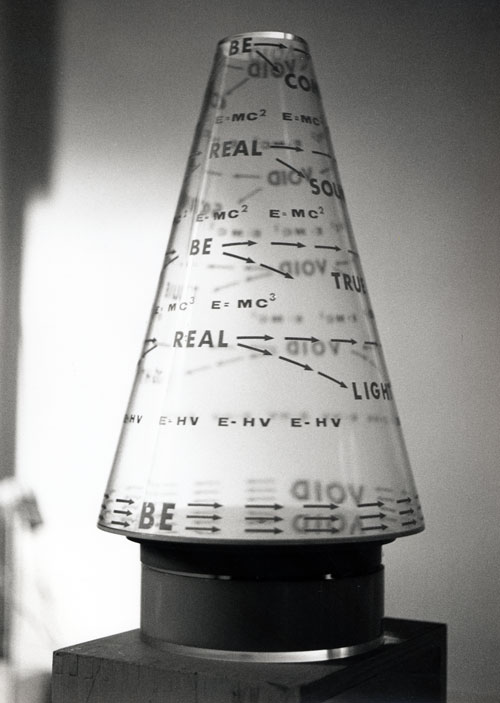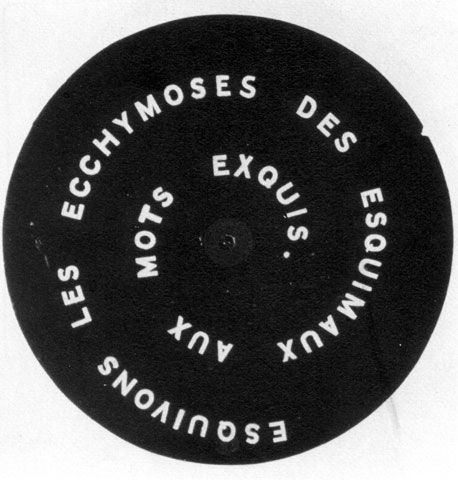 |
| 'Fire Ice Poemcon' 2007 |
 |
| 'Dark matter Poem drum' 2011 |
Liliane Lijn is an american born artist who has lived in London since 1966. She was born in 1939. Her parents were jewish-russian and they talked six different languages in their household in Manhattan. This is what she says gave her such an interest in the meaning or loss of meaning in words.
I really recommend reading this interview with Lijn back in 2014. It is very insightful and I found out things I did not know from wikipedia.
A lot of her Pieces also seem to be based around cones and cylinders which is interesting to me because their main surface is wrapped all the way around rather than a top-down circle which simply isn't as exciting.
 |
| Faster than birds Poemdrum |
 |
In the interview mentioned earlier, Liliane has this to say about the poemdrums: "It started because I had been going to the Science Museum in Paris and I saw a beautiful experiment, which was an experiment in light interference, and I tried to do something similar. I managed to create interference using just lines on cylinders that rotated at a certain speed. And what you’d see, although these lines were black and white, was colour – you’d get colour coming out of it. And then, from that, I thought: “Well, words are made up of letters, and letters are made up of lines, so why not use words?” I thought that might be more interesting.
 |
| 'Poemdrums' |
I started off just using the alphabet and then I was going to do cut-ups from newspapers, but I had a really good friend in Paris, Nazli Nour, and she asked me to work with her poems. It meant cutting them up because they were very long, but she didn’t mind. I started using words from her poems, and then other people asked me to do it with their poems. It was always a question of whose work would be right, and I did find one person, an American poet I met in Greece, Leonard Marshall, whose poetry was just perfect because they were all very, very short poems. He died very young and the only person who published him was me. A lot of the early pieces were his poems and Nazli’s poems, first on drums and then on cones."
Lijn was Artist in Residence in 2005 at NASA’s Jet Propulsion Laboratory and at the Space Sciences Laboratory, University of California, Berkeley, as part of an ACE, NASA, Leonardo Network International Fellowship.
A residency at NASA... wow! I'd love to do that.
 |
| I think that this is my favorite piece by Liliane Lijn. Partially because of the way it's made of transparent glass and the scientific elements. |
 | |||
| This piece is made out of Aerogel; the least dense solid object known to man. It is a fascinating material with weird properties developed for aerospace and spacecraft. |
| ‘If we understand how energy flows, how energy is transferred from one form to another’ says Dr. Andreas Keiling, ‘then we can say that we have understood the phenomena’. Each scientist looks at the movement and transformation of energy in areas as diverse as waveforms in music and maths, solar flares, the building of a spacecraft, the aurora borealis, the mixing of stellar and laser light and the crustal magnetic fields of Mars. Similarly, Lijn’s multi-facetted practice views the world as flux and energy and this video interweaves her work, in a counterpoint to the scientists’ observations, to create a visual/verbal dialogue between science and art.' |
'With all this talk of stardust and lines of light interacting in four dimensions (the fourth being time), it is hard to believe that Lijn’s scientific knowledge is all self-taught. She shrugs this off nonchalantly, however: “That’s all science is, really, observation. I’m just interested in it and so I read.” It seems that a lot of Lijn’s success comes from “just being interested”. Over more biscuits and more tea, we continue to chat.'
I really like Lijn's attitude and approach to her work and her interestedness, especially in science. I feel a very similar way.
The thing that I am making for my project right now is inspired by the rotating movement and interaction with light that a lot of Lijn's pieces do. I also feel like some of her work is an artistic progression of Duchamp and Man Ray's Rotoreliefs which were the initial inspirations for my project.


Above: Stills from Duchamp and Man Ray's 'Anemic Cinema'
 |
| A photo of my work in progress. The disk is spinning quickly on a motor and the material is acetate. |


I have hardly touched the surface on all the things that Liliane is inspired by and has made. She seems very fascinating as does her husband, 'Takis', who I decided to not talk about at all because he isn't relevant to my project.
Overall, I like quite a lot of Lijn's art and find it interesting and see a relevance to my own art.

Overall, I like quite a lot of Lijn's art and find it interesting and see a relevance to my own art.


No comments:
Post a Comment